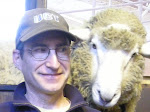Using the internet to buy fabric is a wonderful option if:
a) you don't live near a quilt store
b) your quilt store does not have exactly what you are looking for
c) you need more of a specific pattern of fabric and your quilt store has also run out!
But there are two big things to be aware of:
a) Buying on-line means that you (almost always) will pay shipping fees. So this adds to the cost of your fabric. Since these fees are often based on weight, you might want to buy additional fabric (which you will certainly use for something) and not incur any additional shipping fees.
b) The on-line pictures of the fabric swatches are not always 100% accurate! If you are buying a fabric that you know (for example, if you need more of something), then there should be no problem (other than a possible dye-lot issue). But if you are buying sight-unseen and trying to match other fabrics, what you see is not always what you get.
Thursday, January 29, 2009
Sunday, January 25, 2009
How much fabric should you buy?
Always buy a little more than you need!
Why?
You don’t want to run short.
Dye lots may vary.
You may make a mistake (or even change your mind about a particular fabric once you have started and decide you want to use more than you originally planned). When this happens, it is almost 100% certain that if you go back for more they will tell you they just sold the last piece!!! The internet helps…you can often track down more, but you may have to wait several days for it to arrive and pay extra for shipping (and then there's that dye lot issue!).
And, of course, whatever you don't use in this quilt goes into your stash and becomes FREE fabric for another one down the line!
Why?
You don’t want to run short.
Dye lots may vary.
You may make a mistake (or even change your mind about a particular fabric once you have started and decide you want to use more than you originally planned). When this happens, it is almost 100% certain that if you go back for more they will tell you they just sold the last piece!!! The internet helps…you can often track down more, but you may have to wait several days for it to arrive and pay extra for shipping (and then there's that dye lot issue!).
And, of course, whatever you don't use in this quilt goes into your stash and becomes FREE fabric for another one down the line!
Saturday, January 24, 2009
Avoid set-in ("Y") seams
Whenever I do a tumbling blocks pattern it is ALWAYS with equilateral triangles sewn in rows. No hexagons, no set-in ("Y") seams. It is so much easier this way and, from a few feet away, no one can tell anyway.
In other words, the method of construction DOES NOT have to be the same as the finished pattern itself!
Look at this quilt. You can see from the black triangles (and the star that magically formed in the center) the size and arrangement of the triangles that make up the cubes. They are sewn in rows (left - right - left....) from top to bottom (at a 60 degree angle of course) and then the rows are joined. All straight line seams! But the finished product looks like much complex piecing was done.

Subscribe to:
Comments (Atom)
